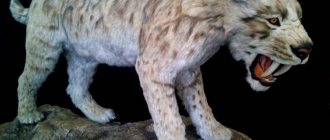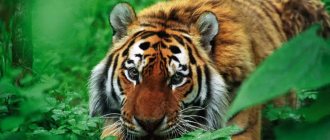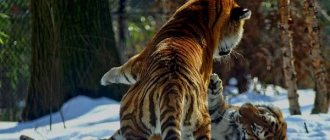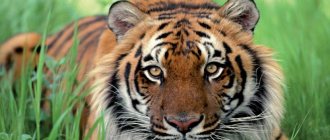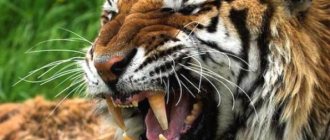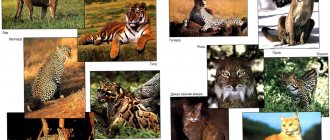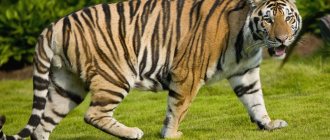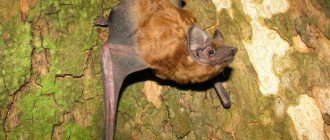Smilodon, better known as the saber-toothed tiger (although this name is incorrect), is a genus of cats that inhabited the North American and South American continents approximately 2,500,000 - 10,000 years ago. The animal had the size of a modern lion, was distinguished by well-developed muscles, had a short tail (up to 25 cm), a body length of 2.5-3.2 meters and weighed 55-400 kg, depending on the species. Body height at the withers could reach up to 120 cm. The genus included three species: fatalis (subspecies: fatalis, floridus, californicus), populator and gracilis. Low genetic diversity, according to geneticists, was the reason for its extinction. Environmentalists attribute this to dramatic climate change on the planet.
Habitats
The extinct species flourished across African lands and also inhabited the Eurasian and North American continents during the Early and Middle Miocene. One of its early representatives, Pseudaelurus quadridentatus, is considered the founder of the evolutionary development of the species.
During the late Miocene, the saber-toothed cat shared territories with the carnivorous barburofelis, which also had sharp front fangs. The last remnants of the species and its representatives disappeared from the Earth without a trace about 10 thousand years ago. Their population was never found on the planet again.
Further reading[edit]
- Mol, D., V. v. Logchem, K. v. Hooijdonk, R. Bakker. Saber-toothed cat
. DrukWare, Norg 2008. ISBN 978-90-78707-04-2. - Sardella, R. "Knowledge Network [v5.6]." SOC PALEONTOLOGICA ITALIANA, C/O E. SERPAGLI, EDITOR, IST DI PALEONTOLOGIA VIA UNIV 4, MODENA, 00000, ITALY, March 10, 2012 Web. October 18, 2012 < https://apps.webofknowledge.com/full_record.do?product=WOS >.
- Anton, Mauricio (2013). Sabretooth
. Bloomington: Indiana University Press. ISBN 978-0253010490.
Evolution of saber-toothed cats
Since this representative of the animal world disappeared from the face of the Earth a long time ago, most of the knowledge about it is the guesswork of scientists. But with the development of genetics, it is possible to discover more and more interesting facts about extinct species. By studying the finds of archaeologists, you can create a certain image and learn at least a little about these mysterious creatures.
Scientists suggest that the saber-toothed cat was very similar to tigers in its habits and hunting, although it was never part of this family. Archaeological excavations have failed to prove that the animals had tiger-like stripes and fluffy fur. Also, there was no evidence confirming the similarity of the habits of ancient cats with modern species, so such statements can be considered nothing more than assumptions.
Scientific research based on DNA studies conducted in 2005 confirms the separation of the “saber-toothed cat” subfamily from the ancestors of our pets, but does not link it to the current species of cats.
Scientists consider the famous saber-toothed tiger, which was not one of the representatives of tiger cats in the Ice Age, to be a typical representative of this fossil group. In the scientific world, it is called Smilodon, which is translated from Latin as “destroyer.”
Rhinoceroses and elephants are not mortal enemies
The myth of hatred between these two species of animals dates back to ancient times. In 1515, King Manuel I of Portugal decided to test this myth. He got a female Indian rhinoceros named Ganda, who found a home in the royal menagerie, away from the elephants. But one day, the king arranged a fight between the animals, with the participation of the royal family and guests. The youngest elephant in the king's menagerie was brought into the arena from the stables. The tapestries hiding the rhinoceros were left open. The official observer writes that the rhinoceros appeared in a rage and immediately attacked his enemy so forcefully that the young elephant broke free of his chains, began to scream loudly and overcame the thick barrier with iron bars. This incident certainly helped support this myth.
Top Articles: What is the difference between a comet and an asteroid?
Smilodon: description of the species
Smilodon is the last member of the saber-toothed cat subfamily. The photo of the animal model is amazing:
- huge, up to 20 centimeters fangs;
- height at the withers reaches one meter and 20 cm;
- body length is more than two meters;
- weight is almost 500 kg.
Such characteristics make these animals the kings of vast territories. The tail alone was 30-35 centimeters long. The stocky build made Smilodon's appearance atypical for felines. Only the cave and American lions were not inferior to him in size.
There is no doubt that the animal was a predator. Few could survive if a saber-toothed cat went hunting. Photos of the individual and its complete skeleton were taken by scientists during excavations in France.
Existing together with other representatives of the animal world, cats competed for hunting and living places with:
- cheetahs and panthers in African lands;
- pumas, lions, jaguars in America.
Ecological niche of mahairod
As scientists suggest, in their ecosystems, mahairods occupied the top step of the food chain.
Scientists believe that mahairods were the top of the food chain in their ecosystems.
They hunted mainly mastodons. At the same time, a connection was noticed between the hunting of mahairods for mastodons and australopithecines, which, apparently, picked up carrion for mahairods. In any case, along with the disappearance of mastodons, mahairods almost immediately disappeared, and after them australopithecines, and this happened in a very short time.
Appearance
Predators were distinguished by conical and saber-toothed fangs. The structure of the Smilodon's jaw was such that it allowed the animal to open its mouth up to 95°; modern representatives of feline predators are able to do this no more than 65°. The exposed, curved teeth were sharp like blades. They reached 20 cm in length. The mighty beast was capable of hunting other animals larger than itself in size. This is what a saber-toothed cat looks like, whose appearance frightened the inhabitants of the American continent two million years ago.
The animal's jaws, designed to kill, placed the animal among the dangerous predators. He had no equal opponents.
A powerful chest and a mass a quarter greater than the weight of a large lion allowed the animals to compete for habitat not only with each other, but also with the short-faced bear, an equally strong and hardy animal. Huge size, a body consisting of strong muscles, and knife-like teeth allowed the predator to hunt the largest representatives of the fauna of that time - mammoths.
Scientists agree that it is impossible to compare an animal with a lion. Yes, the dimensions of his body are commensurate with the dimensions of the king of beasts, but the structure of the build, the proportions of the shapes and the massiveness of the front legs against the background of the short hind legs do not allow such a comparison to be accepted.
The muscular neck and bite force allowed the animal, grabbing prey, to knock it down and tear it to pieces with its claws. There is still debate in the scientific world about how the saber-toothed cat was painted. The predator, in all likelihood, did not have traditional tiger stripes. Most likely, his skin was decorated with dark spots.
Taxonomy
Saber-toothed cats were first divided into three ranks. According to the latest edits, it was decided to divide it into two: Machairodontini and Smilodontini. In addition, the suborders nimravids and barburofelids, which were more similar to ancient martens than to cats, were previously mistakenly classified as saber-toothed.
Machairodontini
Machairodontini lived in North America, Africa and Eurasia. Most of all they resembled modern predatory cats. However, unlike them, they had characteristic fangs. Some representatives reached a height of one and a half meters and weighed 230 kg.
Machairodontini (mahairods) are named after the sword of the same name - mahaira.
Machairods fed on mastodons, as evidenced by the fossilized remains of meat on their powerful teeth
Smilodontini
Smilodontini inhabited America - North and South. These creatures weighed from 150 to 400 kg, depending on the subspecies. They had a short tail, similar to a lynx, and fangs that protruded 28–30 cm from the mouth.
The mouth of Smilodon opened by 120°, while in modern predators it opened only by 60–65°.
Smilodon hunted mammoths and bison and enjoyed eating horse meat
There are three known species of Smilodon:
- gracilis lived in the western regions of America and is considered the ancestor;
- fatalis is the most famous and studied. Its average weight, like that of modern tigers, reached 200 kg;
- populator is a South American giant weighing up to 400 kg. It has two North American varieties, distinguished by more modest dimensions: floridus;
- californicus.
Prehistoric finds
Scientists cannot name the true reasons why such an adapted species of predators, which has all the data for survival, suddenly disappeared from the face of the Earth. Only the fossilized remains of their bones and characteristic teeth remind us of an animal called the saber-toothed cat. Discoveries in Los Angeles's "Magic Mile" amaze the modern world with artifacts from prehistoric America.
Lakes and reservoirs in the region emit frightening vapors, and tar fumes emerge from the bowels of the earth. It was in this place that archaeologists were lucky enough to find the remains of the bones of this animal and many other extinct predators. Puddles of resin, camouflaged by the thick of the forest, became dangerous for many representatives of the animal world. Covered with leaves and fragments of branches, they formed huge traps. Herbivores got stuck in them, thereby attracting predators who faced the same fate.
Excavations in the La Brea areas yielded up to one thousand Smilodon bones, making their number unique. The asphalt and resin filling of the lakes became a good preservative material. The bones are preserved in excellent shape. Scientists were able to get an idea of what saber-toothed cats looked like. Photos of found fossils can be found in anthropological museums.
It should be noted that bones of a short-faced bear and a wolf were found among the remains of the Ice Age. These are the direct ancestors of the predators living on our planet today. But the saber-toothed cat did not leave behind any descendants. At the moment, not a single species of direct descendants of Smilodon, Machairod and other types of saber-toothed cats has been discovered.
Tasmanian wolf in the Red Book
When the Animal Conservation Act was drafted in 1928, the thylacine was not listed as an endangered species. In 1930, the last representative of the wild wolf was shot.
Australian authorities passed a law banning the shooting of predators in 1938. This event occurred two years after the death of the last representative of the species at the zoo. The organization of the island reserve in 1966 looks even more incomprehensible. The government has allocated 647 thousand hectares for breeding a non-existent species.
The thylacine had endangered species status until 1980. In 1982, the Tasmanian wolf was declared extinct after the 50-year waiting period had expired. For fifty years, the International Animal Conservation Association has not received any information about surviving individuals.
Main causes of extinction
The main reasons for the extinction of the species can be considered:
- Colonization of territories by competitive predators.
- Mass extermination of individuals by the mast population.
- Worsening epidemiological situation.
- Relocation of a species to unusual habitats.
- Plague of carnivores. The disease was introduced by white settlers with their domestic animals.
In 2012, scientists found that, in addition to all external threats, wolves were facing extinction due to genetic monotony. Due to geographic isolation, the animals only bred within a limited population. This would sooner or later lead to complete extinction.
Is there potential for a revival of the species?
Despite numerous searches in the territories of Tasmania, Australia and New Guinea, no traces of the existence of the thylacine in the wild have been found. All information received from eyewitnesses does not have documentary evidence.
After 1936, there were several reports of wolves appearing in Tasmania. But the information was not confirmed, so the animal was considered a lost species.
Later in 2022, a similar animal was captured on camera traps. The quality of the photographs does not provide a 100% guarantee that this animal is a thylacine.
In November 2022, a report was received from a woman who allegedly encountered a female and cubs in Hartz Mountains National Park. That same year, two travelers saw animals from a car window. In 2022, near the Sleeping Beauty mountain range, a hunter discovered tracks that strongly resembled the fossilized footprint of a thylacine.
Geneticists have been trying to clone the Tasmanian wolf since 1999. The samples are cubs preserved in alcohol. The DNA samples recovered in 2002 were found to be damaged. The first successes were noted only in 2008. However, it has not yet been possible to clone and raise the marsupial predator.
Behavioral features
Based on its appearance, the saber-toothed cat, whose behavior was characterized by aggressiveness, could not move too fast. This is due to the short tail, which does not allow the body to be held in an upright position during rapid running. Most likely, the animal was hiding in ambush, waiting for the victim, and quickly attacked it.
At the dawn of the Pleistocene period, herds of herbivores were enormous. It was not difficult for predators to get food. Some herbivores were gigantic in size, which did not allow the cat to hunt alone. It is likely that in such a situation the predators hunted in packs. During excavations, several ossified remains of saber-toothed tigers were found near the bones of one herbivore.
Taking care of the flock
The fact that the remains of one tiger had serious injuries that did not allow him to hunt alone indicates the possibility of individuals living in packs, where even a wounded animal could exist at the expense of the hunting of others.
The natural and preferred dish for any predator is meat. Smilodon can be considered a hypercarnivore. Horse and bison protein was found in their bone remains.
Why do they have such teeth?
The question of the presence of teeth in a predator haunted scientists. After all, a lion does not need saber teeth to hunt. To this end, scientists conducted an experiment that recreated the force of a cat's bite. It turned out that it is almost two times lower than that of a lion. It turns out that in modern lions, the strength of the bite determines the size of the prey.
The prehistoric teeth had lethal force if used back and forth. Side-to-side movements could easily damage them, simply breaking them. When a fang got stuck in the victim's body, it easily broke. With the loss of a tooth, the possibility of fruitful hunting was halved, and this threatened death from starvation.
Scientists do not confirm the hypothesis that wounded animals could have been eaten by their own pack members, but they do not reject them either. Perhaps this property of the teeth did not allow representatives of the species to survive to this day. But this is a question for scientists.
Links[edit]
- See, for example, "saber-toothed cat" in the Encyclopædia Britannica. 2009. Encyclopedia Britannica online. October 26, 2009.
- "Palaeobiology Database: Smilodon, basic information". paleodb.org. Retrieved September 6, 2012.
- "Palaeobiology Database: Nimravidae, basic information". paleodb.org. Retrieved September 6, 2012.
- "Palaeobiology Database: Barbourofelidae, basic information". paleodb.org. Retrieved September 6, 2012.
- Barrett, Paul Z. (2016-01-01). "Taxonomic and systematic revisions of North American Nimravidae (Mammalia, Carnivora)". PeerJ
.
4
: e1658. DOI: 10.7717/peerj.1658. PMC 4756750. PMID 26893959. - Anton, Mauricio (2013). Sabertooth Tiger (Life of the Past)
. Indiana University Press. - Meachen-Samuels, Julie A. (2012). "Morphological convergence of the hunting arsenal of saber-toothed predators". Paleobiology
.
38
(1): 1–14. DOI: 10.1666/10036.1. S2CID 86749260. - Carbone, C.; Maddox, T.; Funston, P. J.; Mills, M. G.; Grether, G. F.; Van Valkenburgh, B. (2009). "Parallels between reproduction and Pleistocene resin seepage suggest social identity of the extinct Smilodon saber-toothed cat". Biol. Lett
.
5
(1): 81–85. DOI: 10.1098/RSBL.2008.0526. PMC 2657756. PMID 18957359. - Bi, S.; Jin, X.; Li, S.; Du, T. (2015). "New Cretaceous metatherian mammal from Henan, China". PeerJ
.
3
: e896. DOI: 10.7717/peerj.896. PMC 4400878. PMID 25893149. - Andersson, K.; Norman, D.; Werdelin, L. (2011). "Saber-toothed predators and the killing of large prey". PLOS ONE
.
6
(10): 1–6. Bibcode: 2011PLoSO...624971A. DOI: 10.1371/journal.pone.0024971. PMC 3198467. PMID 22039403. - ^ab Brain, C.K. "Part 2: Fossil assemblages from Sterkfontein caves: analysis and interpretation". In: Hunters or Hunted?: An Introduction to African Cave Taphonomy
. Chicago: University of Chicago Press, 1981. ISBN 0226070891 - Meehan, T. J.; Martin, L. D. (2003). "The extinction and re-evolution of similar adaptive types (ecomorphs) in Cenozoic North American ungulates and carnivores reflect Van der Hammen cycles." Naturwissenschaften
.
90
(3): 131–135. Bibcode: 2003NW…..90..131M. DOI: 10.1007/s00114-002-0392-1. PMID 12649755. S2CID 21117744. - Van Valkenburgh, B. (2007). "Déjà vu: the evolution of predator feeding morphology". Integrative and Comparative Biology
.
47
(1):147–163. DOI: 10.1093/ICB/icm016. PMID 21672827. - https://peerj.com/articles/9346/
- https://royalsocietypublishing.org/doi/10.1098/rspb.2020.1818
- Piras, P; Majorino, L; Terezi, L; Meloro, S; Lucci, F; Kotsakis, T; Raya, P. (2013). "Cat bite: relationship between functional integration and mechanical performance revealed by mandibular geometry". Systematic biology
.
62
(6):878–900. DOI: 10.1093/sysbio/syt053. PMID 23925509. - Piras P, Maiorino L, Teresi L, Meloro C, Lucci F, Kotsakis T, Raia P (2013) Evidence from: Cat bite: relationship between functional integration and mechanical performance revealed by mandibular geometry. Dryad Digital Repository. https://dx.doi.org/10.5061/dryad.kp8t3
Scary but popular
The sight of a prehistoric predator, even one created from the remains of a skeleton, causes a slight shiver. However, saber-toothed cats have become popular not only in the world of artifact finds. The image of a strong, cunning representative of the Ice Age was created by animators in the film of the same name. His images appeared on children's T-shirts, stickers and backpacks. Animal figurines could be found in a toy store.
We want to associate everything unknown and uncontrollable with traits of conventional nobility. Of course, the saber-toothed tiger is an invention of artists, but to create its image on the screen, masters of the genre used and took into account the features of the skeleton of an animal that actually lived on Earth millions of years ago. Even watching a cartoon character, one can note his predatory independence and independence.
